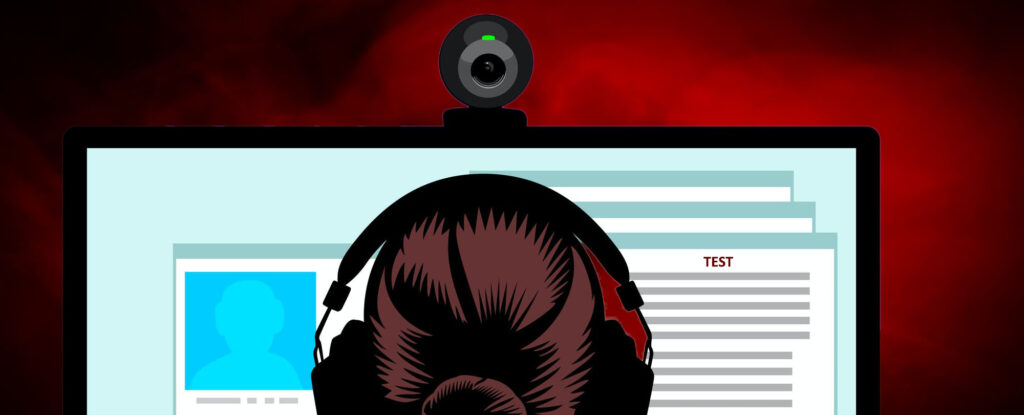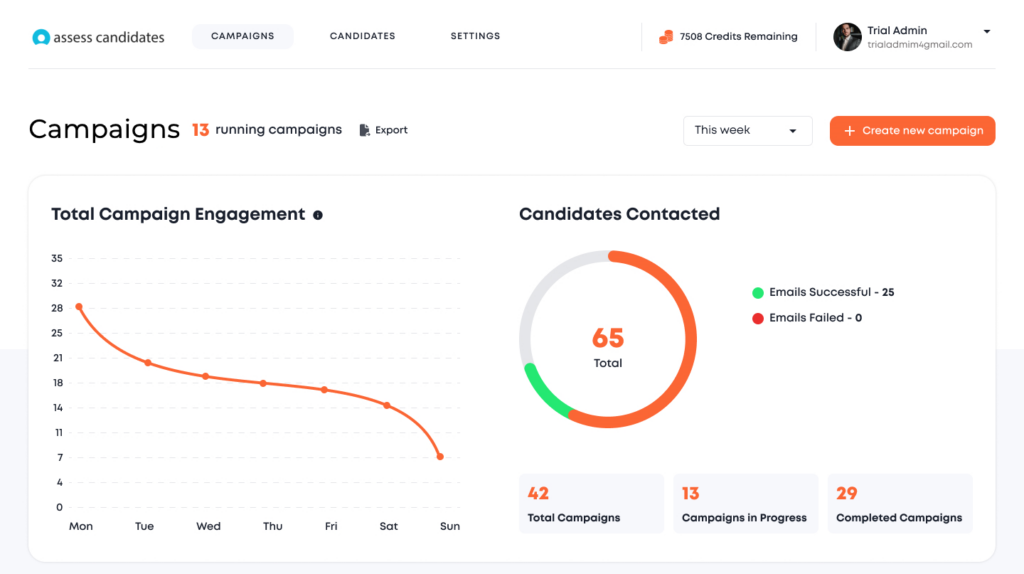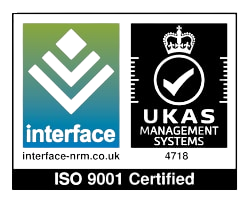Understanding cheater detection and how it can help when using psychometric assessments for hiring
Maintaining fairness and accuracy in recruitment assessments is key. Discover the critical tool of cheater detection with our comprehensive guide for recruiters and HR specialists. In this article, we cover everything you need to know about the use of cheater detection methods when designing assessment processes for your company.
We will begin by defining the concept of cheater detection with respect to recruitment assessments. We will then explore the methods and technologies employed in cheater detection – from AI-powered algorithms to biometrics and data analytics. Next, we will cover the advantages that implementing cheater detection can bring you as a recruiter. Finally, we will offer practical tips on how to successfully integrate cheater detection into your assessment process.
Prepare to embark on a journey to discover the power of cheater detection in assessments and learn how it can transform your recruitment practices.
Contents:
- What is cheater detection in hiring assessments?
- What methods and technologies are used for cheater detection?
- What are examples of organizations employing cheater detection mechanisms?
- What are the benefits of cheater detection technologies for employers?
- What are some of the most important tips for integrating cheater detection into your assessment process?
- How do Assess Candidates help with cheater-detection?
- FAQs and Glossary of terms
Benefit from reliable assessment solutions with us. Hire For Free
1. What is Cheater Detection in assessments?
Cheater detection in assessments is an important component of modern evaluation processes designed to maintain fairness, accuracy, and integrity among all recruitment candidates. Cheater detection refers to various methods and technologies used to identify and deter cheating during recruitment evaluations. In today’s digital landscape, where remote and online assessments have become commonplace, cheater detection plays a key role in ensuring that all candidates are evaluated on a level playing field.
Between 30 – 50% candidates cheat in entry level job assessments.
HirePro
What are examples of companies providing cheater detection software?
Example 1: ProctorU’s AI-Powered Monitoring
Companies like ProctorU employ cutting-edge AI-driven proctoring solutions to oversee candidates during online assessments. These systems use webcams and microphones to monitor test-takers in real-time. If any suspicious behavior is detected, such as unusual eye movements or unauthorized access to external resources, the candidate is flagged for further review. ProctorU’s technology ensures that candidates are held to the same standards of integrity as in traditional in-person assessments.
Example 2: Honorlock’s Secure Proctoring
Honorlock is another company at the forefront of cheater detection. Their platform uses AI to track candidate activities during online exams. For instance, if a candidate tries to open additional browser tabs or access external websites, Honorlock’s system alerts administrators to potential cheating attempts. This proactive approach helps maintain the authenticity of the assessment process.

In essence, cheater detection methods like these are indispensable tools that not only protect the integrity of assessments but also ensure that employers like yourself can confidently select the most qualified candidates based on their true abilities and knowledge.
2. What methods and technologies are used for cheater detection?
Now let us take a look at the examples of anti-cheating solutions. Companies offering cheater detection services employ a range of strategies to maintain the integrity of assessments. Take a look at these.
5 examples of cheater detection technologies.
- AI-Powered Algorithms: Many organizations utilize artificial intelligence (AI) algorithms to monitor candidate behavior during online assessments. These algorithms are trained to recognize patterns of cheating, such as irregular keystroke dynamics or suspicious eye movements. For example, companies like ExamSoft employ AI to analyze data from the candidate’s computer, tracking mouse movements and screen interactions to detect any anomalies.
- Facial Recognition: Biometric technologies, including facial recognition, play a crucial role in cheater detection. By comparing a candidate’s facial features to their ID photo, platforms like ProctorU ensure that the person taking the assessment is indeed the registered candidate. Any disparities can trigger alerts for further investigation.
- Screen Sharing Monitoring: Some cheater detection systems, like Proctorio, keep a vigilant eye on screen-sharing activities. Multiple faces appearing on the webcam or unauthorized screen sharing can raise red flags and prompt the system to notify administrators.
- Environmental Analysis: Cheater detection technologies often incorporate environmental analysis. They may assess background noise levels, lighting conditions, or the presence of other individuals in the room to identify potential irregularities.
- Behavioral Analysis: Advanced cheater detection systems can also perform behavioral analysis by monitoring how a candidate interacts with the assessment. Rapid changes in focus, excessive scrolling, or attempts to copy-paste text can all trigger alerts.
These technologies work together to create a comprehensive approach to cheater detection, ensuring that candidates are evaluated based on their genuine skills and knowledge, free from deceptive practices. As an employer, you can rely on these methods to maintain the fairness and credibility of their assessment processes.
3. What are examples of organisations employing cheater detection mechanisms?
Various anti-cheating technologies are currently being used by numerous organisations in their recruitment assessments, spanning diverse sectors. Take a look at a few examples.

What are some examples of organizations using anti-cheating mechanisms?
- Educational Institutions: Renowned institutions like Harvard deploy ProctorU and Honorlock to ensure the authenticity of online examinations, preserving the fairness and credibility of their academic evaluations.
- Certification Bodies: A leading certification body in the IT industry, CompTIA relies on robust cheater detection methods to uphold the legitimacy of their certifications, assuring employers that certified professionals possess the required skills.
- Corporations: Prominent corporations like IBM partner with assessment providers such as Pearson VUE and Prometric to identify qualified job applicants. By implementing cheater detection measures, they ensure fair evaluations in their recruitment processes.
- Government Agencies: Federal Bureau of Investigation (FBI): Government agencies like the FBI utilize stringent cheater detection techniques in their recruitment assessments and security clearance evaluations. These measures are vital in selecting individuals who adhere to ethical standards in sensitive roles.
Enhance your assessment process with tried and tested assessments. View Plans
4. What are the benefits of cheater detection technologies for employers?
Having seen examples of various organizations using cheater detection mechanisms in their assessments, let us analyze the benefits of such an approach to companies like yours.
Cheater detection technologies offer employers a competitive advantage by ensuring fairness, reducing risks, and maintaining the credibility of their assessment procedures. Benefits of such technologies translate into more effective hiring processes and stronger employer branding.

5 benefits cheater detection adds to your hiring process
- Enhanced Hiring Accuracy: Cheater detection technologies ensure that candidates are evaluated solely on their genuine skills and knowledge. This results in more accurate assessments, allowing employers to make informed hiring decisions based on candidates’ merit.
The average cost of a bad hire can cost up to $15,000.
Career Builder
- Risk Mitigation: By identifying and deterring cheating, employers minimize the risk of selecting unqualified candidates who might otherwise manipulate the assessment process. This safeguards the organization from potential legal and financial repercussions associated with hiring under qualified individuals.
- Improved Credibility: Organizations that employ cheater detection mechanisms uphold the credibility of their recruitment and certification processes. This, in turn, boosts their reputation among job seekers, students, and clients who value integrity and fairness.
- Efficient Screening: Cheater detection technologies streamline the screening process by automatically flagging suspicious behavior. This reduces the administrative burden of manual monitoring and allows for a more efficient assessment workflow.
82% of businesses are currently using some form of pre-employment tests in their recruitment process.
SHRM
- Candidate Trust: When candidates know that assessments are conducted with integrity, they are more likely to trust the evaluation process and view the organization in a positive light. This can enhance the candidate experience and attract top talent.
5. What are some of the most important tips for integrating cheater detection into your assessment process?
Integrating cheater detection effectively requires a strategic approach to ensure a smooth and ethical assessment experience for candidates. Wondering where to start?
What are the 6 key tips to integrate cheater detection in your recruitment?
- Transparency: Communicate clearly with candidates about the cheater detection methods in place. Providing information about the technology and its purpose builds trust and reduces candidate anxiety.
- Training: Train administrators and proctors on the proper use of cheater detection tools. They should understand how to interpret alerts and take appropriate action.
- Test Run: Conduct a trial run of the assessment with cheater detection to identify and resolve any technical or logistical issues before the actual assessment.
- Privacy: Respect candidate privacy by only monitoring what is necessary for cheater detection. Ensure data security and compliance with privacy regulations.
- Accessibility: Ensure that your assessment platform is accessible to all candidates, including those with disabilities, while maintaining cheater detection integrity.
- Continuous Improvement: Regularly update and refine your cheater detection strategies as technology evolves and new cheating tactics emerge.
By following these tips, organizations like yours can effectively integrate cheater detection mechanisms into their assessment processes, preserving fairness while upholding ethical and privacy standards.
6. How do Assess Candidates help with cheater-detection?
We are a trusted recruitment partner to companies of all sizes, with long experience in designing, implementing and monitoring recruitment assessment processes for our clients. We offer a reliable solution incorporating the latest technology and cheater detection mechanisms.
5 Ways Assess Candidates helps with Cheater Detection
- Copy and Paste Block: We block copy and paste shortcuts to make it more difficult for people to lift content and cheat when taking our assessments.
- Added Time Pressure: We use stringent time allowances per assessment to reduce the opportunity for candidates to look elsewhere for solutions.
- Randomized Assessments: We offer randomized ability tests so no two candidates will receive the same questions.
- End-to-End Assessments: We encourage the use of preference, ability and behavioral assessments with the former not easily cheatable given the nature of assessment and question styles.
- Bespoke Customization: We work closely with all our partners to identify other areas by which we may address cheater detection further.

Practical example of how Assess Candidates ensure cheating-free assessment processes.
Problem:
Your company has struggled in the past with candidates cheating their assessment tests, whether by outsourcing their assessment tests to other people, or by using unallowed resources during the process.
Assess Candidates Solution:
Leverage randomized ability tests, ensuring all candidates receive a different set of questions. Reduce time allowances further as needed, offering candidates an assessment with even greater time pressure to minimize opportunity for cheating to take place.
7. FAQs and Glossary of terms
FAQs (Frequently Asked Questions):
- How do cheater detection technologies impact candidate privacy?
- Cheater detection technologies are designed to focus on candidate behavior that may indicate cheating. They respect candidate privacy by monitoring only what is necessary for assessment integrity. Data security and compliance with privacy regulations are top priorities.
- Can candidates with disabilities participate in assessments with cheater detection measures?
- Yes, it’s essential to ensure accessibility for all candidates. Assess Candidates employs inclusive design principles to accommodate candidates with disabilities while maintaining the integrity of the cheater detection process.
- How often should cheater detection strategies be updated?
- Cheating tactics evolve, so it’s crucial to regularly review and refine your cheater detection strategies. Frequent updates keep your assessment process robust and aligned with the latest technology and cheating trends.
- How do I know if my organization needs cheater detection technologies in candidate assessments?
- Determining the need for cheater detection technologies depends on various factors, including the importance of assessment integrity in your hiring process and the potential consequences of cheating. If your organization values the fairness and accuracy of candidate evaluations and seeks to maintain a level playing field for all applicants, integrating cheater detection measures can be a proactive step. It’s also beneficial when handling high-stakes assessments where the impact of cheating could be detrimental.
- Are there any best practices for communicating the use of cheater detection technologies to candidates?
- Absolutely, transparency is key. When utilizing cheater detection technologies in your assessment process, it’s important to inform candidates upfront. We recommend including a clear statement in your communication materials and on your assessment platform’s landing page. This should explain the purpose and methods of cheater detection, emphasizing that it’s to ensure a fair and trustworthy evaluation process. Additionally, offer candidates the opportunity to ask questions or seek clarification on how their data will be used and protected. Providing this information helps build trust and ensures candidates are aware of the steps taken to maintain assessment integrity.
- How are false positives and false negatives addressed in cheater detection technologies?
- Cheater detection technologies aim to strike a balance between identifying potential cheating instances and minimizing false positives and false negatives. Our system employs algorithms and human oversight to reduce both types of errors. False positives (incorrectly identifying cheating) and false negatives (failing to detect actual cheating) are continually assessed and refined to ensure the most accurate results while maintaining fairness in candidate assessments.
Glossary of Terms:
- AI-Powered Proctoring: An advanced assessment technology that utilizes artificial intelligence algorithms to monitor and detect suspicious behavior during online assessments.
- Authentication Solutions: Techniques and technologies used to verify the identity of candidates, ensuring that they are who they claim to be.
- Behavioral Analysis: The examination of candidate actions and interactions during assessments to identify patterns indicative of cheating or dishonest behavior.
- Privacy Regulations: Legal frameworks, such as GDPR or HIPAA, that govern the collection, storage, and use of candidate data, ensuring privacy and data protection.
- Inclusive Design: Design principles and practices that ensure that assessment processes and technologies are accessible to all, including candidates with disabilities, while maintaining fairness and integrity.
